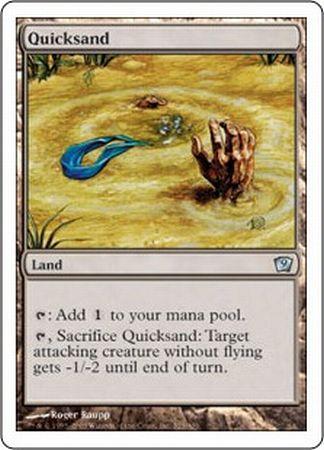
METHOD 1

METHOD 1
| Q1.i22:
However, the lead-grey center floor is actually
a 10-foot-deep pool of viscous quicksand. Any character who steps onto this AREA falls in (no SAVE). The victim fights, defends, and saves at -4, loses Dexterity adjustments (if any), and may NOT CAST spells. The victim sinks to the bottom of the pool in 1-4 rounds, and dies (of suffocation) in that time. A victim at the edge of the quicksand may climb out, but this takes a number of rounds equal to 1d6 + 10 minus the 1 round for each person helping. If the victim hangs onto a secured rope, of course, sinking is avoided. (Note that water breathing is of no use, but an airy water spell will prolong Life for 1-4 rounds, after which the character dies from dust inhalation. Adaptation, such as from the necklace, allows breathing while in the quicksand.) |
METHOD 2
| N5.24: 3. Quicksand:
One of the horses wanders
into some quicksand and begins to sink, taking the rider with it. The horse will sink in 2d6 rounds
|
METHOD 3
In any swamp
or wet, low-lying AREA, characters may "stumble"
upon a patch of quicksand -- and area where
water has saturated
the ground to such an extent (and such
a depth) that the
terrain is thick and mushy. Despite its
name, quicksand can be
composed of earth as well as sand; in such
a case, the "quicksand"
is nothing more than a mudhole, which can
be dealt with in
the same manner described in the preceding
text on mudslides.
Quicksand that is actually
composed of sand is somewhat
more treacherous than "muddy" quicksand,
because the water-and-sand
mixture is generally not as thick as a
mudhole, which
means that someone who walks or falls into
it will sink more quickly.
However, contrary to the popular impression,
quicksand
does not "suck" a victim beneath the surface.
Someone who
keeps his wits about him, and his head
above the surface, can
save himself by treading water and (if
he has proficiency in swimming)
making his way along the surface to a place
of safety.
A character who falls into quicksand is
in the same situation as
someone who is caught in a mudslide (see
the text at left). A
nearby companion may be able to help a
non-swimmer by extending
a pole or branch that the victim can grab
to help pull himself
out. A rescuer who enters the quicksand
to help a companion
must have proficiency in swimming; otherwise,
he will find himself
in the same situation. A swimmer can enter
quicksand and
pull a victim to safety without jeopardizing
himself.
| Natural Hazards in the Wilderness | WSG |